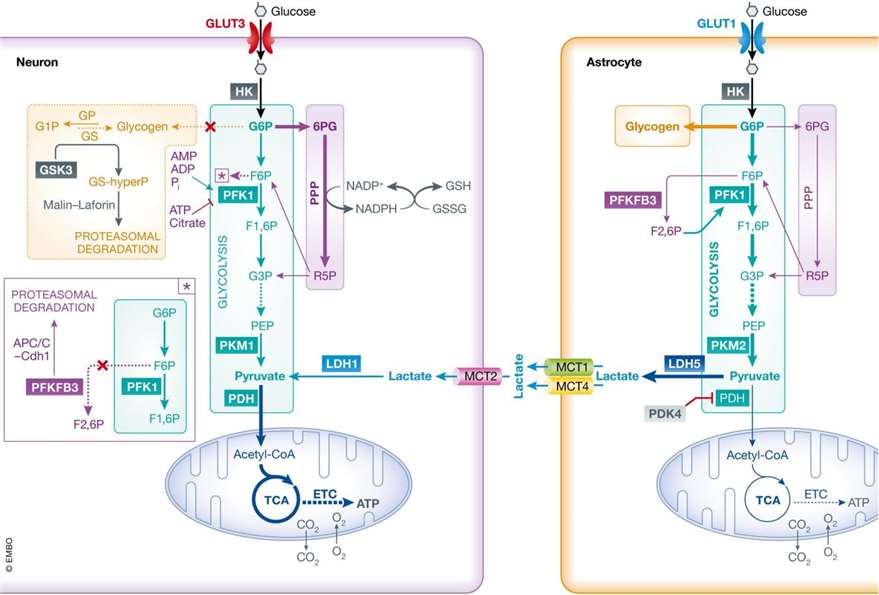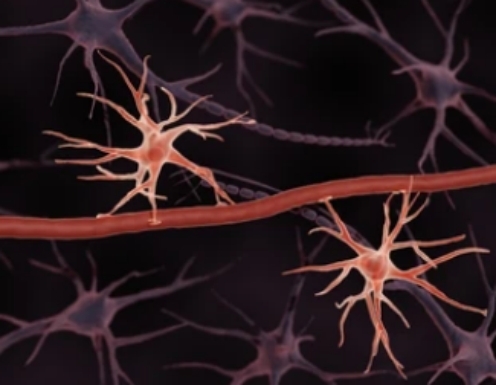Brain cells typically respond adaptively to bioenergetic challenges generated by sustained activity in neuronal circuits and therefore require large amounts of energy. Over the past decades, metabolic flux analysis (MFA) has been applied to cerebral metabolic fluxes in vitro and in vivo studies, providing valuable information on cerebral metabolic compartmentation, neuro-glial metabolic interactions, and the individual contribution of neurons and astrocytes to brain energetics.
 Fig.1 Metabolic pathways of glucose utilization in neurons and astrocytes.
(Camandola, Simonetta, and Mark P. Mattson, 2017)
Fig.1 Metabolic pathways of glucose utilization in neurons and astrocytes.
(Camandola, Simonetta, and Mark P. Mattson, 2017)
Overview of brain metabolism
Although the brain makes up only 2% of the total body weight, it accounts for 20% of an individual's resting energy expenditure. Brain activities such as making decisions and planning complex behaviors, all require large amounts of energy. In brain cells, neurons consume 70-80% of the total energy and the rest is used by astroglial cells. Previous studies have shown that increases in metabolic rate, as well as fat deposition and changes in the distribution of energy supply, are critical for the evolution of brain size and complexity. In addition, metabolic alterations have been shown to strongly influence the initiation and progression of many neurodegenerative diseases, such as Alzheimer's disease (AD), Parkinson's disease (PD), amyotrophic lateral sclerosis (ALS), and Huntington's disease (HD). The rate of glucose and oxygen metabolism in brain cells is declining during the normal aging process and is further exacerbated in the neurodegenerative diseases described above.
Our service
Understanding the metabolic profile of brain cells and their metabolic networks will not only advance our understanding of how the brain functions and adapts to environmental demands, but may also further reveal the mechanisms by which age-related neurodegenerative diseases occur in the human brain. Creative Proteomics offers nuclear magnetic resonance (NMR) and mass spectrometry (MS)-based metabolic flux service combined with several stable isotope tracers, such as 13C and 15N. Our team is able to help our clients identify and quantify specific metabolic pathways and perform more comprehensive studies of cellular metabolism in brain cells.
Workflow of our service
- Experimental design
- Primary neuron and astrocyte cultures
- Sample preparation
- Metabolic incubation experiments
- NMR, GC-MS and LC-MS-based measurements
- Metabolic modeling construction
- Data processing
- Delivery of result reports and interpretation
Applications of our service

- Brain metabolism in aging
As we age, brain energy use declines. Studies have shown that glucose hypometabolism and mitochondrial dysfunction are early indicators of age-related functional changes in the normal aging brain.
- Brain metabolism in neurodegenerative disorders
Neurodegenerative disorders including AD, PD, ALS and HD are a broad spectrum of fatal conditions characterized by progressive neuronal dystrophic structural changes and functional loss. They share several mechanistic similarities at the subcellular level. There is growing evidence that metabolic alterations strongly influence the initiation and progression of these diseases.
References
- Camandola, Simonetta, and Mark P. Mattson. "Brain metabolism in health, aging, and neurodegeneration." The EMBO journal 36.11 (2017): 1474-1492.
- Barros, L. Felipe, et al. "Current technical approaches to brain energy metabolism." Glia 66.6 (2018): 1138-1159.